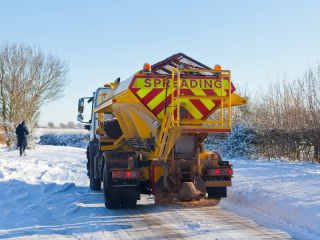
Every winter, icy roads pose a significant challenge for drivers, leading to an increased risk of accidents and collisions. Understanding stopping distances on icy roads is crucial for ensuring road safety during the cold months.
In this article, we’ll delve into the factors that influence stopping distances on icy roads and explore effective strategies for drivers to navigate these hazardous conditions with caution and confidence.
What is stopping distance?
Stopping distance on the roads refers to the total distance a vehicle travels from the moment the driver applies the brakes until the vehicle comes to a complete stop. It is influenced by factors such as the vehicle's speed, the driver's reaction time, and the vehicle's braking capabilities.
The stopping distance comprises two main components: the thinking distance (the distance travelled during the driver's reaction time) and the braking distance (the distance travelled while the vehicle is slowing down).
Factors contributing to increased stopping distance in icy conditions
The AA estimates that braking distance is 10 times higher on icy roads than on dry roads, significantly impacting stopping distance. Several factors contribute to this, and they should always be considered when driving in icy conditions.
Reduced traction
Ice reduces the traction between your tyres and the road surface, affecting overall braking effectiveness. This can result in longer stopping distances, reduced control over the vehicle, and an increased risk of skidding.
You should adjust your driving behaviour and maintain a safe following distance to account for decreased traction and ensure safe braking.
Longer reaction times
Due to the slippery condition of ice, you could experience delayed responses from your vehicle, leading to longer stopping distances.
To account for the slower reaction times, it’s important to maintain a greater distance between you and other vehicles. This helps to ensure you have enough time to brake and prevents accidents on the road.
Ineffective braking systems
Anti-Lock Brake Systems (ABS) are a safety feature found in most modern vehicles. They’re designed to prevent your wheels from locking up if the brakes are applied suddenly. Although this can help reduce skidding in icy conditions, ABS can fail or malfunction which could lead to a loss of control in emergency braking manoeuvres.
Setting up a vehicle service and maintenance plan can ensure your braking system is working effectively, so you’re prepared for the winter months.
Effects of vehicle speed and weight
The effects of vehicle speed and weight on icy conditions can significantly impact driver safety. Increased speed can reduce traction and control, leading to a higher risk of accidents and heavier vehicles may require longer stopping distances.
Influence of speed
When driving on icy roads, reduced friction and traction make it more difficult for tyres to maintain grip, especially during acceleration, braking, and cornering. Higher speeds intensify these challenges, increasing the likelihood of skidding.
Additionally, the stopping distance of a vehicle on icy roads is significantly longer and this must be taken into consideration when driving at higher speeds.
We recommend you slow down in icy conditions, but if you were to drive at 70mph, it would take 771m to stop. Therefore, you need to be vigilant and maintain a safe distance from any vehicles in front.
Impact of vehicle weight
Heavier vehicles require longer stopping distances, especially on slippery surfaces, due to increased momentum and inertia. This can make it more challenging to bring the vehicle to a stop and puts additional strain on the tyres, further impacting their ability to grip the road.
Discover our top safety tips for HGV drivers.
Safe driving tips for icy conditions
Driving in winter can be hazardous, so you must understand the potential risks and how to overcome them. By following these top tips, you can prevent accidents on the road, keeping yourself and other road users safe.
Reduce speed
Reducing speed in icy conditions is crucial for maintaining safety on the road. By slowing down, you can mitigate the risk of skidding, loss of control, and collisions. Harsh acceleration should also be avoided as this can cause wheel spin.
Additionally, driving at a reduced speed gives you more time to react to unexpected hazards and changes in road conditions.
Increase following distance
As icy conditions greatly increase your stopping distance, particularly if you drive an HGV, it’s important to ensure an appropriate following distance. By increasing your following distance, you can provide yourself with more time to respond to unexpected events, such as the vehicle in front suddenly braking or encountering a slippery patch of road.
This additional space also reduces the likelihood of rear-end collisions and provides a buffer for adjusting speed or changing lanes if necessary.
Brake gently
To maintain control and traction in icy conditions, you must brake gently. When road surfaces are icy and wet, harsh braking can lead to skidding due to the reduced friction between the tyres and the road.
Applying gentle and gradual pressure on the brake pedal allows the tyres to maintain a better grip on the icy surface, reducing the risk of skidding and enabling more controlled deceleration.
Stopping distance in icy conditions is influenced by several factors, including vehicle speed, weight, tyre condition, road surface, and braking systems. Reducing speed, increasing following distance, and braking gently are essential strategies for mitigating the risks associated with reduced traction and slippery surfaces.
However, drivers need to exercise caution, adapt their driving behaviour, and constantly assess road conditions to ensure safety. While understanding the impact of various factors on stopping distance is crucial, proactive and defensive driving remains the cornerstone of navigating icy roads responsibly.



